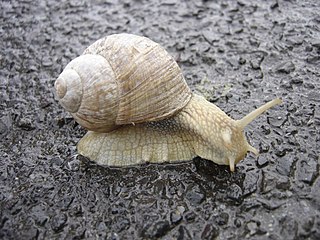
A snail is a shelled gastropod. The name is most often applied to land snails, terrestrial pulmonate gastropod molluscs. However, the common name snail is also used for most of the members of the molluscan class Gastropoda that have a coiled shell that is large enough for the animal to retract completely into. When the word "snail" is used in this most general sense, it includes not just land snails but also numerous species of sea snails and freshwater snails. Gastropods that naturally lack a shell, or have only an internal shell, are mostly called slugs, and land snails that have only a very small shell are often called semi-slugs.
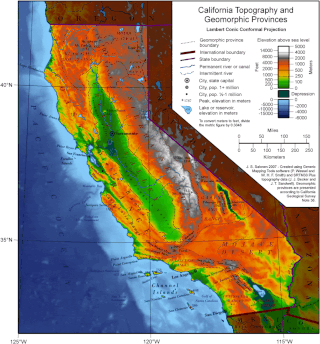
California is a U.S. state on the western coast of North America. Covering an area of 163,696 sq mi (423,970 km2), California is among the most geographically diverse states. The Sierra Nevada, the fertile farmlands of the Central Valley, and the arid Mojave Desert of the south are some of the geographic features of this U.S. state. It is home to some of the world's most exceptional trees: the tallest, most massive, and oldest. It is also home to both the highest and lowest points in the 48 contiguous states.
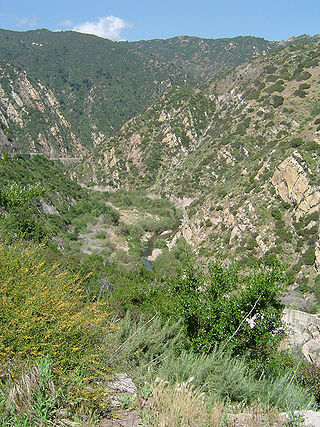
The Santa Monica Mountains are a coastal mountain range in Southern California, next to the Pacific Ocean. It is part of the Transverse Ranges. The Santa Monica Mountains National Recreation Area encompasses this mountain range. Because of its proximity to densely populated regions, it is one of the most visited natural areas in California.

The San Gabriel Mountains comprise a mountain range located in northern Los Angeles County and western San Bernardino County, California, United States. The mountain range is part of the Transverse Ranges and lies between the Los Angeles Basin and the Mojave Desert, with Interstate 5 to the west and Interstate 15 to the east. The range lies in, and is surrounded by, the Angeles and San Bernardino National Forests, with the San Andreas Fault as its northern border.
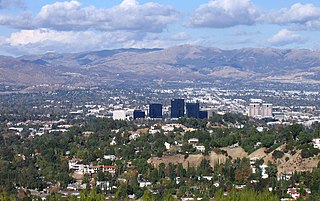
The Santa Susana Mountains are a transverse range of mountains in Southern California, north of the city of Los Angeles, in the United States. The range runs east-west, separating the San Fernando and Simi valleys on its south from the Santa Clara River Valley to the north and the Santa Clarita Valley to the northeast. The Oxnard Plain is to the west of the Santa Susana Mountains.

The Santa Clara River is an 83 mi (134 km) long river in Ventura and Los Angeles counties in Southern California. It drains parts of four ranges in the Transverse Ranges System north and northwest of Los Angeles, then flows west onto the Oxnard Plain and into the Santa Barbara Channel of the Pacific Ocean.

The Santa Ana River is the largest river entirely within Southern California in the United States. It rises in the San Bernardino Mountains and flows for most of its length through San Bernardino and Riverside counties, before cutting through the northern Santa Ana Mountains via Santa Ana Canyon and flowing southwest through urban Orange County to drain into the Pacific Ocean. The Santa Ana River is 96 miles (154 km) long, and its drainage basin is 2,650 square miles (6,900 km2) in size.

The Angeles National Forest (ANF) of the U.S. Forest Service is located in the San Gabriel Mountains and Sierra Pelona Mountains, primarily within Los Angeles County in southern California. The ANF manages a majority of the San Gabriel Mountains National Monument.

The San Gabriel River is a mostly-urban waterway flowing 58 miles (93 km) southward through Los Angeles and Orange Counties, California, in the United States. It is the central of three major rivers draining the Greater Los Angeles Area, the others being the Los Angeles River and Santa Ana River. The river's watershed stretches from the rugged San Gabriel Mountains to the heavily-developed San Gabriel Valley and a significant part of the Los Angeles coastal plain, emptying into the Pacific Ocean between the cities of Long Beach and Seal Beach.

The foothills of the San Gabriel Valley are the foothills and hills in the San Gabriel Valley of eastern Los Angeles County, California. They include the foothills of the San Gabriel Mountains, and independent low mountain ranges of hills, in the east Greater Los Angeles region. The landforms are part of the Transverse Ranges System of Southern California and Baja California.

The Verdugo Mountains, also known as the Verdugo Hills or simply The Verdugos, are a small, rugged mountain range of the Transverse Ranges system in Los Angeles County, California. Located just south of the western San Gabriel Mountains, the Verdugo Mountains region incorporates the cities of Burbank, Glendale, Pasadena, and La Cañada Flintridge; the unincorporated communities of Altadena and La Crescenta-Montrose; as well as the City of Los Angeles neighborhood of Sunland-Tujunga.

Heliciculture, commonly known as snail farming, is the process of raising edible land snails, primarily for human consumption or cosmetic use. The meat and snail eggs a.k.a. white caviar can be consumed as escargot and as a type of caviar, respectively.

The Santa Ana sucker is a freshwater ray-finned fish, endemic to California. It is closely related to the mountain sucker and has dark grey upper parts and silvery underparts. It grows to a maximum length of 25 cm (10 in), but most adults are much smaller than this. It feeds on algae, diatoms and detritus on the floor of shallow streams with sand, gravel or cobble bottoms. It is found in only a few streams in southern California, and many of these in the Greater Los Angeles metropolitan area have been restricted to concrete channels. Because of its small area of occupancy and vulnerability, the International Union for Conservation of Nature has rated this fish as "endangered".
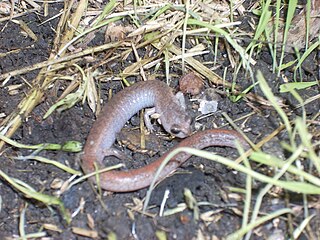
The Garden slender salamander or Southern California slender salamander is a species of salamander in the family Plethodontidae. It is endemic to northern Baja California in Mexico and Southern California in the United States.
The San Jose Hills are a part of the Transverse Ranges in eastern Los Angeles County, California, marking the border between the San Gabriel Valley and the Pomona Valley. It includes portions of Covina, West Covina, Walnut, Pomona, and San Dimas. To the south, the valley of San Jose Creek separates the San Jose Hills from the Puente Hills and Chino Hills.

Glyptostoma is a genus of air-breathing land snails, terrestrial pulmonate gastropod mollusks in the family Megomphicidae.
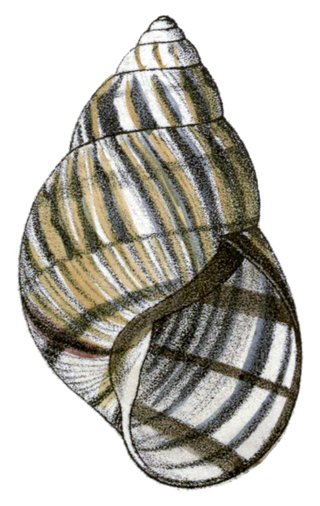
Orthalicus reses, the Stock Island tree snail or the Florida tree snail, is a species of large tropical air-breathing tree snail, a terrestrial pulmonate gastropod mollusk in the family Orthalicidae. It was first described in 1830 by the American naturalist Thomas Say. The holotype, a specimen probably collected in Key West, was subsequently lost. Over a hundred years later, in 1946, the American biologist Henry Augustus Pilsbry redescribed the species using a specimen from Stock Island, Florida. Orthalicus reses has two subspecies, O. reses reses and O. reses nosodryas. The validity of these two taxa is still being discussed, but some experts argue that considering them as independent units may be important for management purposes.
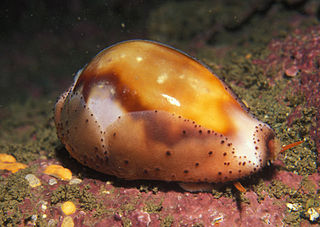
Neobernaya spadicea, common name the chestnut cowrie, is a species of sea snail in the cowrie family, Cypraeidae. Chestnut cowries can be found in the eastern Pacific Ocean, from central California to Baja California. The chestnut cowrie has a highly glossy shell due to an enamel that is secreted from its mantle.

Sonorella neglecta is a terrestrial pulmonate gastropod mollusc in the subfamily Helminthoglyptinae. Sonorella is a genus of large land snails consisting of over 80 species, with new ones continuing to be described. The shells typically differ only rather subtly, but proportions of the genitalia differentiate species. The genus is distributed in the southwestern USA and northern Mexico, with individual species often restricted to a single mountain massif or to a small part of one. Sonorella neglecta is such a narrow-range endemic from the Chiricahua Mountains. Its official vernacular name is the Portal Talussnail.

Anguispira kochi, the banded tigersnail, is a species of pulmonate terrestrial gastropod belonging to the family Discidae, the disk snails. There are two recognized subspecies: Anguispira kochi kochi or the eastern banded tigersnail, and Anguispira kochi occidentalis, the western banded tigersnail.




















